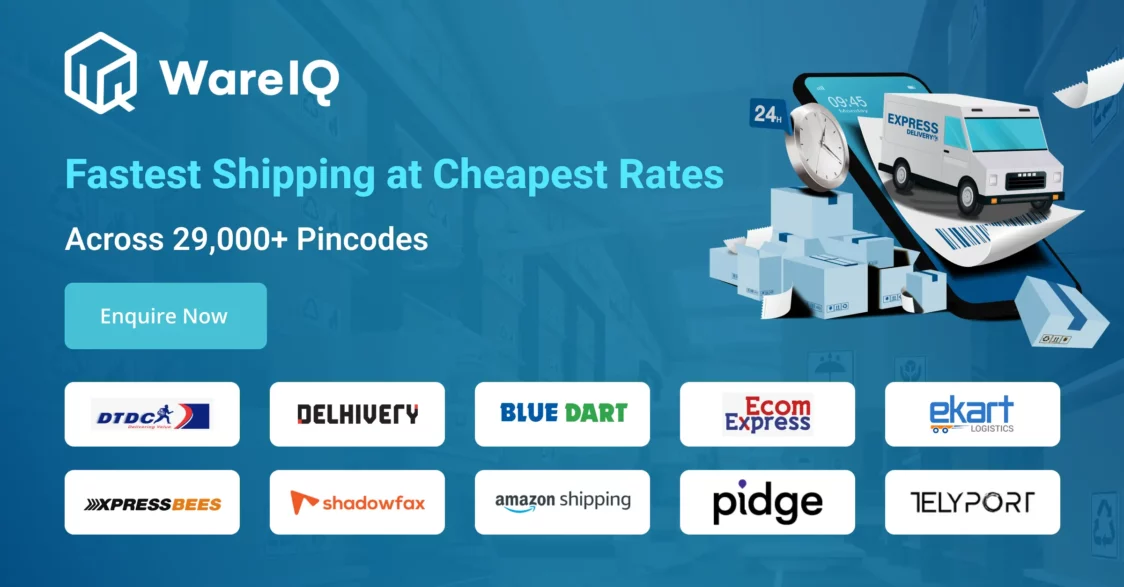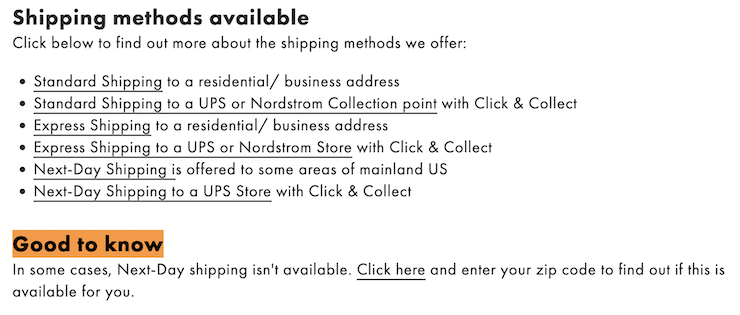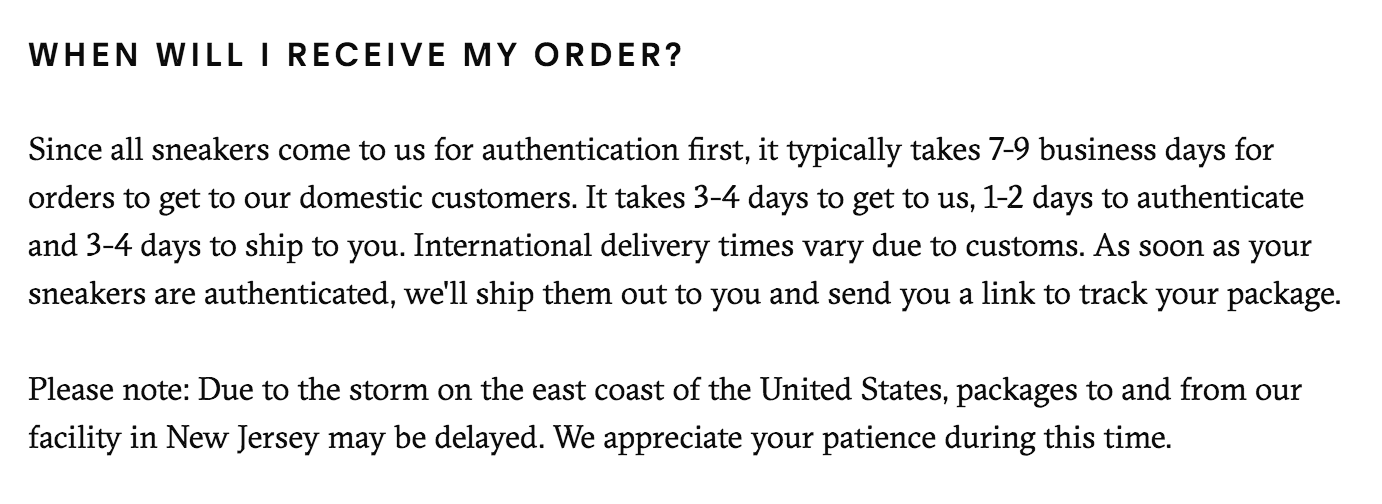Everything You Need to Know About Creating a Shipping Policy Including Examples and Things to Include in Your Shipping Policy for eCommerce Website Transparency

Due to the highly competitive nature of eCommerce, most online companies constantly strive to find ways to make them stand out from the rest. This could be through providing a unique service, selling a niche product, offering large discounts or even something as mundane as offering efficient and transparent shipping. eCommerce Shipping is one of the most important procedures in eCommerce as it enables customers to receive the items they have ordered and paid for.
Therefore, most customers expect not only a smooth purchasing experience but also a pleasant shipping and delivery encounter. One way to do this is to help set the expectations of customers as to what the shipping procedure entails, how much time it will take and how much it will cost for that item. This can be done by providing a clear and concise shipping policy in easily accessible locations. In this blog, we will go into the ins and outs of what a shipping policy is, its advantages, the best places to display it, tips to improve it, real-world examples, and 7 important things it should include.
- What is a Shipping Policy and Who Requires it?
- What are the Advantages of Using a Shipping Policy for eCommerce?
- Best Locations to Display Your Shipping Policy for eCommerce Website Visibility
- How Can You Enhance the Functionality of Your eCommerce Shipping Policy?
- Real-World Examples and Templates of Shipping Policies
- How to Create Shipping Policy for eCommerce and D2C Website? Which are the Essential Elements that Should be Included in Your Shipping Policy?
- Conclusion: Use WareIQ’s Services to Improve Your Shipping Policy and Provide Domestic and International Shipping
- Shipping Policy: FAQs
What is a Shipping Policy and Who Requires it?
A shipping policy is a set of guidelines or terms that a company establishes regarding the shipping of its products or services to customers. It outlines the rules, procedures, and fees related to the delivery of goods and the expectations that both the customer and the company should have when it comes to the shipping process. A shipping policy usually includes details on shipping methods, delivery times, order tracking, shipping costs & fees, and any other relevant information related to the shipping process.
It also covers issues such as lost or damaged packages, returns and cancellations. Having a clear shipping policy can help customers understand what to expect when ordering from a company while also helping the company manage its shipping processes efficiently and effectively. The types of companies that generally need to provide a shipping policy for eCommerce website transparency include:
- Retail companies
- Online Stores
- Large MNCs
- Small-scale startups
- Specialty businesses
WareIQ, an eCommerce fulfillment company, empowers online brands with a superior-tech platform to compete with Amazon like service levels by bringing their average delivery timelines from 5-10 days to 1-2 days.
What are the Advantages of Using a Shipping Policy for eCommerce?
Addresses Customer Queries
Customers generally have a ton of questions before making a purchase, especially pertaining to shipping, such as delivery costs, carriers used, expected shipping timeline and much more. If this information is not easily visible on your website and you don’t have an automated website chatbot in place, your customer care team may receive an influx of queries and could easily get overloaded if there aren’t many employees handling it.
Therefore, to avoid any confusion and provide all the answers that customers are looking for, you can simply provide your shipping policy on the home page, listing page or any other place that customers spend a lot of time on.
Reduces Cart Abandonment Rates
Customers are generally skeptical about purchasing online, especially in a country like India, where it is still gaining popularity, even though eCommerce has proven to be generally reliable. Cart abandonment can happen for a variety of reasons, a big one being that customers aren’t aware of when they will receive their products and how much shipping will cost them.
If they expect to be paying a certain amount for a product, only to proceed to the checkout page and realise that an additional shipping amount has been imposed, they may instantly abandon their cart and move to another site. Providing a shipping policy ensures that customers will know what they are getting into and will help push them to purchase what they want.
Enhances Your Internal Shipping Procedures
Your shipping policy not only directly responds to numerous inquiries from customers but also addresses a number of internal problems that can arise. Your staff can provide more accurate eCommerce customer service by defining your shipping and delivery procedures in writing. They will also know the rules and structure they need to follow to guarantee that all customers receive their products on time.
Just like how a shipping policy can answer customer queries, it can also serve as a guideline for what needs to be done in case an employee is in the dark and needs some instant assistance. This will help iron out any inefficiencies that could exist in your shipping procedures and make shipping operations more streamlined.
Suggested Read: What are Ways to Streamline Shipping Processes in 2023?
Best Locations to Display Your Shipping Policy for eCommerce Website Visibility
Dedicated Help Page
We advise setting up a help page that includes helpful information such as frequently asked questions, website navigation tips, your shipping policy, terms and conditions, return and exchange policies and other pertinent agreements that need to be easily accessed by your customers.
Checkout Page
The checkout and payment pages are where the most crucial links, including your shipping policy, should be placed. By including a link to your policy on these pages, you can help your users with any last-minute lingering inquiries they may have before making a purchase. Because of this, it will also dissuade any urges to abandon their cart before they make the payment.
Web Page Footer
No matter what page of your website a visitor browses, they will always be able to see the links to your shipping policy in the footer because it is a permanent interface element of your website. Thus, it is the perfect place to provide access to your shipping policy so that customers can easily view it whenever they need to.
How Can You Enhance the Functionality of Your eCommerce Shipping Policy?
Ensure That it is Simple to Understand
Since the ultimate goal of linking your shipping policy in highly visible places is so that the most number of clients are able to read and understand it, try to write it using simple and transparent language. Avoid using complex terms and even if you are necessitated to use them, provide a small description of what it means so that customers won’t come away with more doubts as opposed to less.
Provide Free Shipping and Other Discounts
The type of shipping policy you use can make your company stand out amidst a sea of multiple alternatives, particularly if you provide perks like quick shipment or competitive pricing. For instance, as a promotion for the holidays, you can provide momentarily lower shipping rates, which you can advertise in a banner or popup at a strategic location on your website. This will help give users the impression that they should act fast to avail of the discounted pricing and will encourage them to purchase more items.
Offer Local Customers Multiple Shipping Options
To draw in more local clients, you should alter your shipping policy to permit on-site pickup or dropshipping choices. If you operate a physical store, you could implement a “purchase online, pick up in-store” procedure, which you could describe in a section of your shipping policy. Even better, you can leverage delivery apps to offer your nearby clients an alternative delivery option.
Real-World Examples and Templates of Shipping Policies
A Shipping Policy Targeting Local Customers
- Company: Nordstrom
- Details: More than 2 years since the height of the pandemic, many physical and online stores like Nordstrom are still reeling from the effects and have embraced local customers by providing multiple shipping and delivery options, as mentioned in the previous section. To create a seamless client experience, the company made use of these localised options to begin favouring local sales and revised its shipping page with concise bullet points outlining how each option functions. The company specifies a window where orders can be collected and provides an estimated arrival time for local deliveries.
A Shipping Policy That is Spread Across Multiple Pages
- Company: Billy!
- Details: Billy! is a clothing and accessory company that disperses its shipping guidelines throughout various shipping pages to avoid overcrowding important information onto a single page and making it unreadable. The bulk of their customer’s needs are taken into account in a straightforward, two-part section on their main shipping page. However, there are links on this page that direct users to related pages where they can get more information about things such as order processing and global delivery. This helps demarcate each section so it is easily understandable.
A Shipping Policy That Uses Tables to Highlight Shipping Options and Other Information
- Company: Maono Technology
- Details: Delivery schedules must occasionally be made very apparent to the buyer. For example, if your commodities are often bought as gifts or for special occasions, customers would need to understand how long they would take to ship and how much they would need to spend. To ensure customers are satisfied, every order should arrive according to this schedule. One firm that follows this pattern is Maono Technology, which offers audio-based technology products. For both their standard and express shipping options, they break down their arrival schedules by country and also specified the order processing time and dispatch location.
How to Create Shipping Policy for eCommerce and D2C Website? Which are the Essential Elements that Should be Included in Your Shipping Policy?

7 Must-Have Elements in Your Shipping Policy of eCommerce and D2C website in 2023 are mentioned below:
Shipping Fees
Even though it might seem like a no-brainer, we have to specify that your shipping policy should mention your shipping costs. Provide as much specific information as you can so that your consumers are aware of the potential costs associated with placing an order through your website. Unforeseen shipping expenses play a big part in cart abandonment, so being transparent about your shipping costs based on the product, shipping location and more, can ensure that customers feel comfortable with their choice of purchasing from your store.
Courier Options
It is important to specify the geographic areas that are eligible for your domestic and international shipping services. You can also separate out international shipping into its own area where you can list the nations you ship to and the anticipated arrival dates to those countries. If you provide a variety of shipping choices, you can mention them in a table to make the data easily viewable. This will help customers understand where they stand in terms of their delivery location and if they qualify for certain benefits based on their location.
Delivery Estimates
All customers generally want to know when their packages will arrive, especially if they’re buying something as a gift for a special occasion like a birthday or holiday. Additionally, with most companies providing tracking screens with real-time updates and constant delivery estimations, customers have grown accustomed to having access to this information. Add a sentence to your shipping policy explaining how long it typically takes to process orders when they come in and how much time it can take for consumers to get their orders.
Order Limitations
Due to circumstances that are beyond your control, orders could take longer to arrive. You can let customers know about what types of order limitations could affect their delivery and how these situations would be handled by your company on your shipping policy page on your website. This will help customers understand the course of action and will make them feel more at ease in the event of order delays or other instances that can affect order delivery.
Handling of Misplaced Items
If you run an online store, you would already be aware of the fact that things can occasionally go wrong prior to a customer receiving an order. It’s in your best interest to include a provision in your shipping policy outlining your procedure for lost or misplaced packages, including ones that never arrive. By doing this, you can let your clients know what to anticipate and have a reference point if they have any questions or concerns.
Order Processing Duration
You should specify how long it takes to prepare a shipment after an order is placed. If you’re omitting weekends and/or holidays, or if you have deadlines for processing orders, it is important to let people know, such as information that orders confirmed after 5 pm will only be processed and dispatched on the next working day. You should also modify your processing timings to account for changes that arise in your supply chain and may affect your delivery schedules, such as additional demand or delays with your courier company.
Return and Exchange Policies
In addition to allowing returns by mentioning the specifics in your return policy, you can also describe how your company handles refunds, order modifications, exchanges and what needs to be done in the event that an item is lost or damaged. These policies can affect a customer’s decision with regard to purchasing from your store so it is best to be upfront about how these situations will be handled. You should also find the balance between offering a flexible returns policy and ensuring that you preserve your finances on returned items.
Conclusion: Use WareIQ’s Services to Improve Your Shipping Policy and Provide Domestic and International Shipping
Providing an easily-visible shipping policy on your website or listing pages has numerous benefits and has been statistically proven to increase trust and reduce cart abandonment for eCommerce companies that include them. A shipping policy acts as a guiding principle not only for your customers but also for your employees.
By simply having a small inlay or banner that contains it, customers can instantly get all the information they need relating to your shipping and delivery procedures, enabling them to have more trust in your company and that they will get their goods on the promised date and time. There are also plenty of templates floating around the internet to help you start displaying it immediately by just editing and including your company’s shipping information. If you need help with providing a sound shipping policy in addition to domestic and international shipping, order fulfillment, inventory storage and a whole lot more, WareIQ can be of assistance.
WareIQ is one of the most prominent eCommerce fulfillment firms and has showcased immense growth. Retailers can transport their goods practically anywhere within the country and the world through our WareIQ Global platform, which provides the facilities and infrastructure needed for seamless and efficient shipping. We provide the following features to help with this:
Shipping Policy Assistance
We can help you create a shipping policy that fits your requirements in addition to also providing shipping badges on your listing pages that indicate the shipping speed of that particular item.
Worldwide Shipping
We offer dependable and affordable shipping facilities to more than 220 countries and territories around the globe, including the UK, US, EU and Australia, and have worked with the majority of major international shipping companies, including FedEx, DHL, and more.
Suggested Read: Top 10 Fastest and Cheapest International Courier Services in for eCommerce Sellers
Several Inventory Storage Options
We provide localised storage facilities in the nations you would like to ship to, including the UK, and have worked with numerous warehouse and fulfillment firms worldwide. Also, you have the option of keeping your inventory domestically and exporting each order as it comes in.
Last-Mile Delivery
We offer last-mile delivery facilities to every order’s final location within India as well as the majority of foreign countries that we ship to.
Flexible and Economical Prices
We provide some of the most affordable rates in the sector coupled with numerous incentives and discounts on large orders, enabling you to maintain and increase your profit margins on every order.















